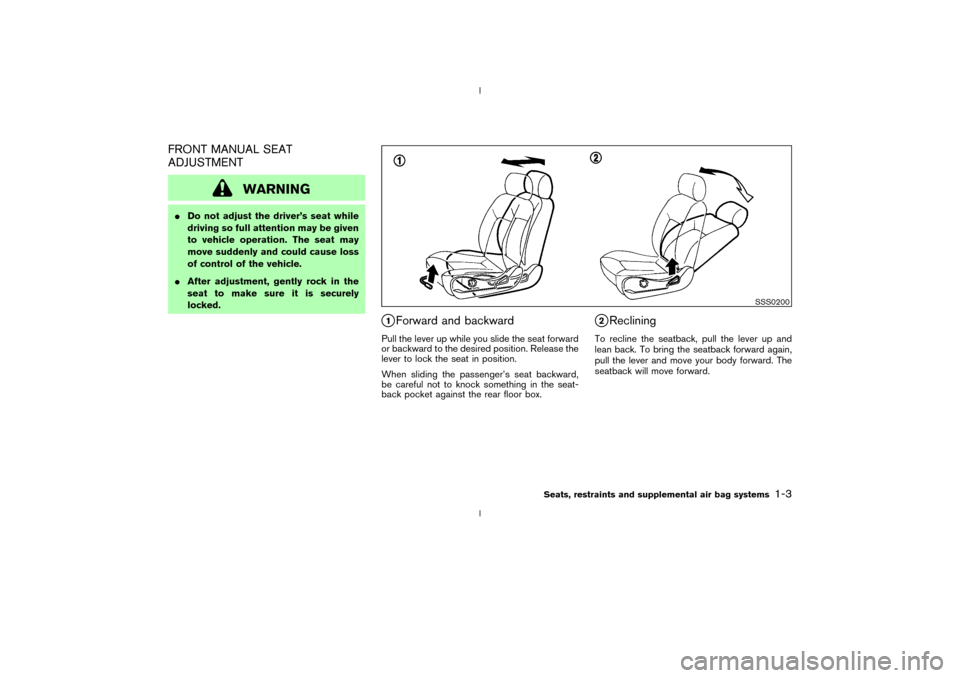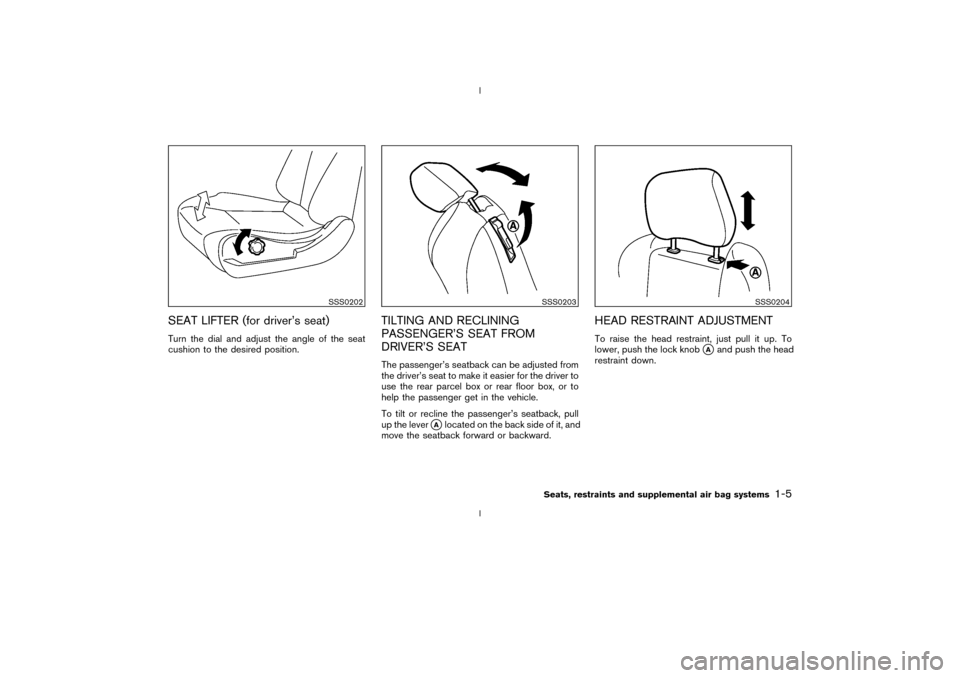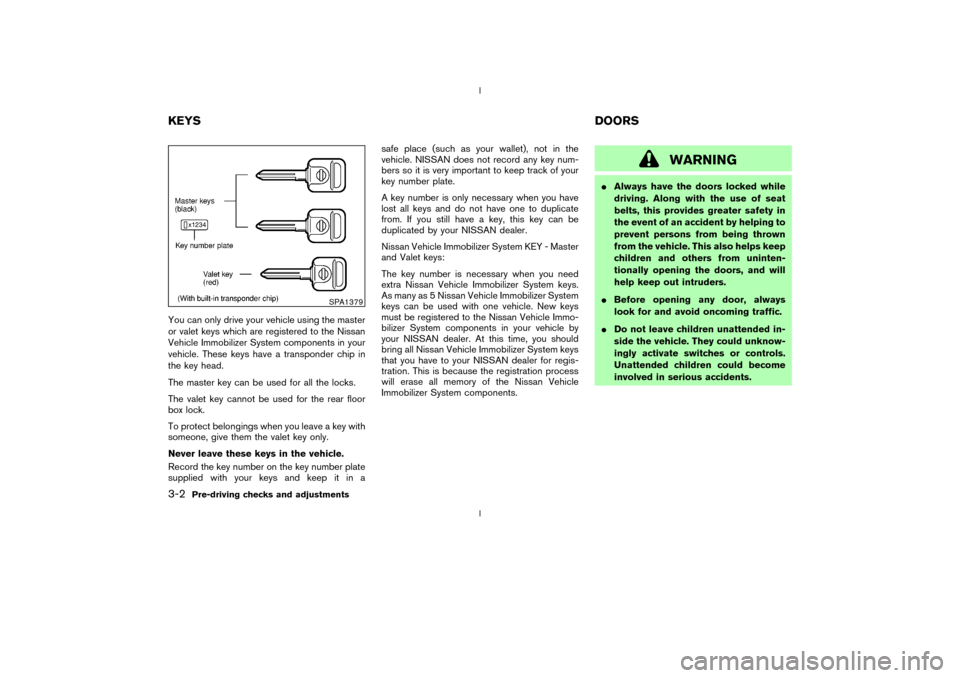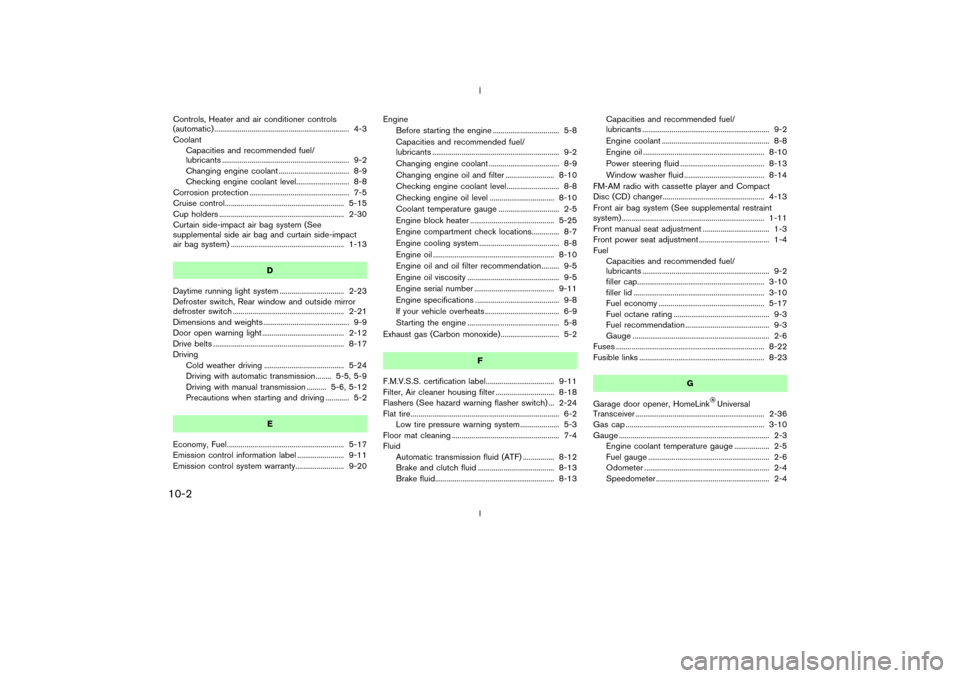2003 NISSAN 350Z seat adjustment
[x] Cancel search: seat adjustmentPage 5 of 227

Table of
Contents
Seats, restraints and supplemental air bag systemsInstruments and controlsPre-driving checks and adjustmentsHeater, air conditioner and audio systemsStarting and drivingIn case of emergencyAppearance and careMaintenance and do-it-yourselfTechnical and consumer informationIndex
Z
02.9.13/Z33-D/V5.0
X
Page 6 of 227

1 Seats, restraints and supplemental air
bag systemsSeats ......................................................................................... 1-2
Front manual seat adjustment....................................... 1-3
Front power seat adjustment (if so equipped) ......... 1-4
Seat lifter (for driver's seat) ........................................... 1-5
Tilting and reclining passenger's seat from driver's
seat ...................................................................................... 1-5
Head restraint adjustment.............................................. 1-5
Supplemental restraint system ........................................... 1-6
Precautions on supplemental restraint system ......... 1-6
Components of the supplemental restraint
systems ............................................................................ 1-11
Supplemental air bag warning labels ....................... 1-16
Supplemental air bag warning light .......................... 1-16
Seat belts .............................................................................. 1-18Precautions on seat belt usage ................................. 1-18
Child safety ..................................................................... 1-20
Obtaining an air bag ON/OFF switch...................... 1-21
After an air bag ON/OFF switch is installed.......... 1-21
Pregnant women ............................................................ 1-21
Injured persons............................................................... 1-22
Three-point type seat belt ........................................... 1-22
Seat belt extenders ....................................................... 1-24
Seat belt maintenance ................................................. 1-24
Child restraints ..................................................................... 1-25
Precautions on child restraints................................... 1-25
Top tether strap child restraint................................... 1-27
Installation on front passenger seat.......................... 1-28
Z
02.9.13/Z33-D/V5.0
X
Page 8 of 227

FRONT MANUAL SEAT
ADJUSTMENT
WARNING
IDo not adjust the driver's seat while
driving so full attention may be given
to vehicle operation. The seat may
move suddenly and could cause loss
of control of the vehicle.
IAfter adjustment, gently rock in the
seat to make sure it is securely
locked.
q1Forward and backward
Pull the lever up while you slide the seat forward
or backward to the desired position. Release the
lever to lock the seat in position.
When sliding the passenger's seat backward,
be careful not to knock something in the seat-
back pocket against the rear floor box.
q2Reclining
To recline the seatback, pull the lever up and
lean back. To bring the seatback forward again,
pull the lever and move your body forward. The
seatback will move forward.
SSS0200
Seats, restraints and supplemental air bag systems
1-3
Z
02.9.13/Z33-D/V5.0
X
Page 9 of 227

FRONT POWER SEAT
ADJUSTMENT (if so equipped)
WARNING
IDo not adjust the driver's seat while
driving so full attention may be given
to vehicle operation.
IDo not leave children unattended in-
side the vehicle. They could unknow-
ingly activate switches or controls.
Unattended children could become
involved in serious accidents.Operating tipsIThe seat motor has an auto-reset overload
protection circuit. If the motor stops during
operation, wait 30 seconds, then reactivate
the switch.
IDo not operate the power support seat
for a long period of time when the engine is
off. This will discharge the battery.
q1Forward and backward
Moving the sliding switch forward or backward
will slide the seat forward or backward to the
desired position.
When sliding the passenger's seat backward,
be careful not to knock something in the seat-
back pocket against the rear floor box.
q2Reclining (for driver's seat)
Move the reclining switch backward until the
desired angle is obtained. To bring the seatback
forward, move the switch forward and move your
body forward. The seatback will move forward.q2Reclining (for passenger's seat)
The passenger's seat is equipped with a manual
lever for reclining. See ªFront manual seat ad-
justmentº earlier in this section.
SSS0201
1-4
Seats, restraints and supplemental air bag systems
Z
02.9.13/Z33-D/V5.0
X
Page 10 of 227

SEAT LIFTER (for driver's seat)Turn the dial and adjust the angle of the seat
cushion to the desired position.
TILTING AND RECLINING
PASSENGER'S SEAT FROM
DRIVER'S SEATThe passenger's seatback can be adjusted from
the driver's seat to make it easier for the driver to
use the rear parcel box or rear floor box, or to
help the passenger get in the vehicle.
To tilt or recline the passenger's seatback, pull
up the lever
qAlocated on the back side of it, and
move the seatback forward or backward.
HEAD RESTRAINT ADJUSTMENTTo raise the head restraint, just pull it up. To
lower, push the lock knob
qAand push the head
restraint down.
SSS0202
SSS0203
SSS0204
Seats, restraints and supplemental air bag systems
1-5
Z
02.9.13/Z33-D/V5.0
X
Page 31 of 227

possible for even the strongest adult
to resist the forces of a severe acci-
dent. The child could be crushed be-
tween the adult and parts of the ve-
hicle. Also, do not put the same seat
belt around both your child and your-
self.
INever install a child restraint in the
front seat unless an air bag ON/OFF
switch has been installed and the air
bag has been turned OFF. An inflat-
ing supplemental air bag could seri-
ously injure or kill your child.
IAn improperly installed child re-
straint could lead to serious injury or
death in an accident.
In general, child restraints are designed to be
installed with the lap portion of a three-point type
seat belt.
The proper restraint depends on the child's size.
Generally, infants (up to about 1 year and less
than 20 lb (9 kg) should be placed in rear facing
child restraints. Front facing child restraints are
available for children who outgrow rear facing
child restraints.Child restraints for infants and children of various
sizes are offered by several manufacturers.
When selecting any child restraint, keep the
following points in mind:
Ichoose only a restraint with a label certifying
that it complies with Federal Motor Vehicle
Safety Standard 213 or Canadian Motor
Vehicle Safety Standard 213.
Icheck the child restraint in your vehicle to be
sure it is compatible with the vehicle's seat
and seat belt system.
Iif the child restraint is compatible with your
vehicle, place your child in the child restraint
and check the various adjustments to be sure
the child restraint is compatible with your
child. Always follow all recommended proce-
dures.
All US states and Canadian provinces re-
quire that infants and small children be
restrained in approved child restraints at
all times while the vehicle is being oper-
ated.
WARNING
IImproper use of a child restraint can
result in increased injuries for boththe infant or child and other occu-
pants in the vehicle.
IFollow all of the child restraint manu-
facturer's instructions for installation
and use. When purchasing a child
restraint, be sure to select one which
will fit your child and vehicle. It may
not be possible to properly install
some types of child restraints in your
vehicle.
IIf the child restraint is not anchored
properly, the risk of a child being
injured in a collision or a sudden stop
greatly increases.
IAdjustable seatbacks should be po-
sitioned to fit the child restraint, but
as upright as possible.
IAfter attaching the child restraint,
test it before you place the child in it.
Tilt it from side to side. Try to tug it
forward and check to see if the belt
holds the restraint in place. If the
restraint is not secure, tighten the
belt as necessary, or put the restraint
in another seat and test it again.
1-26
Seats, restraints and supplemental air bag systems
Z
02.9.13/Z33-D/V5.0
X
Page 83 of 227

You can only drive your vehicle using the master
or valet keys which are registered to the Nissan
Vehicle Immobilizer System components in your
vehicle. These keys have a transponder chip in
the key head.
The master key can be used for all the locks.
The valet key cannot be used for the rear floor
box lock.
To protect belongings when you leave a key with
someone, give them the valet key only.
Never leave these keys in the vehicle.
Record the key number on the key number plate
supplied with your keys and keep it in asafe place (such as your wallet), not in the
vehicle. NISSAN does not record any key num-
bers so it is very important to keep track of your
key number plate.
A key number is only necessary when you have
lost all keys and do not have one to duplicate
from. If you still have a key, this key can be
duplicated by your NISSAN dealer.
Nissan Vehicle Immobilizer System KEY - Master
and Valet keys:
The key number is necessary when you need
extra Nissan Vehicle Immobilizer System keys.
As many as 5 Nissan Vehicle Immobilizer System
keys can be used with one vehicle. New keys
must be registered to the Nissan Vehicle Immo-
bilizer System components in your vehicle by
your NISSAN dealer. At this time, you should
bring all Nissan Vehicle Immobilizer System keys
that you have to your NISSAN dealer for regis-
tration. This is because the registration process
will erase all memory of the Nissan Vehicle
Immobilizer System components.
WARNING
IAlways have the doors locked while
driving. Along with the use of seat
belts, this provides greater safety in
the event of an accident by helping to
prevent persons from being thrown
from the vehicle. This also helps keep
children and others from uninten-
tionally opening the doors, and will
help keep out intruders.
IBefore opening any door, always
look for and avoid oncoming traffic.
IDo not leave children unattended in-
side the vehicle. They could unknow-
ingly activate switches or controls.
Unattended children could become
involved in serious accidents.
SPA1379
KEYSDOORS3-2
Pre-driving checks and adjustments
Z
02.9.13/Z33-D/V5.0
X
Page 221 of 227

Controls, Heater and air conditioner controls
(automatic) ..................................................................... 4-3
Coolant
Capacities and recommended fuel/
lubricants ................................................................. 9-2
Changing engine coolant .................................... 8-9
Checking engine coolant level........................... 8-8
Corrosion protection ................................................... 7-5
Cruise control............................................................. 5-15
Cup holders ................................................................ 2-30
Curtain side-impact air bag system (See
supplemental side air bag and curtain side-impact
air bag system) .......................................................... 1-13
D
Daytime running light system ................................. 2-23
Defroster switch, Rear window and outside mirror
defroster switch ......................................................... 2-21
Dimensions and weights ............................................ 9-9
Door open warning light .......................................... 2-12
Drive belts ................................................................... 8-17
Driving
Cold weather driving ......................................... 5-24
Driving with automatic transmission........ 5-5, 5-9
Driving with manual transmission .......... 5-6, 5-12
Precautions when starting and driving ............ 5-2
E
Economy, Fuel............................................................ 5-17
Emission control information label ........................ 9-11
Emission control system warranty......................... 9-20Engine
Before starting the engine .................................. 5-8
Capacities and recommended fuel/
lubricants ................................................................. 9-2
Changing engine coolant .................................... 8-9
Changing engine oil and filter ......................... 8-10
Checking engine coolant level........................... 8-8
Checking engine oil level ................................. 8-10
Coolant temperature gauge ............................... 2-5
Engine block heater ........................................... 5-25
Engine compartment check locations.............. 8-7
Engine cooling system ......................................... 8-8
Engine oil .............................................................. 8-10
Engine oil and oil filter recommendation......... 9-5
Engine oil viscosity ............................................... 9-5
Engine serial number ......................................... 9-11
Engine specifications ........................................... 9-8
If your vehicle overheats ...................................... 6-9
Starting the engine ............................................... 5-8
Exhaust gas (Carbon monoxide).............................. 5-2
F
F.M.V.S.S. certification label................................... 9-11
Filter, Air cleaner housing filter .............................. 8-18
Flashers (See hazard warning flasher switch) ... 2-24
Flat tire............................................................................ 6-2
Low tire pressure warning system .................... 5-3
Floor mat cleaning ....................................................... 7-4
Fluid
Automatic transmission fluid (ATF) ................ 8-12
Brake and clutch fluid ....................................... 8-13
Brake fluid............................................................. 8-13Capacities and recommended fuel/
lubricants ................................................................. 9-2
Engine coolant ....................................................... 8-8
Engine oil .............................................................. 8-10
Power steering fluid ........................................... 8-13
Window washer fluid ......................................... 8-14
FM-AM radio with cassette player and Compact
Disc (CD) changer.................................................... 4-13
Front air bag system (See supplemental restraint
system) ......................................................................... 1-11
Front manual seat adjustment .................................. 1-3
Front power seat adjustment .................................... 1-4
Fuel
Capacities and recommended fuel/
lubricants ................................................................. 9-2
filler cap................................................................. 3-10
filler lid ................................................................... 3-10
Fuel economy ...................................................... 5-17
Fuel octane rating ................................................. 9-3
Fuel recommendation ........................................... 9-3
Gauge ...................................................................... 2-6
Fuses ............................................................................ 8-22
Fusible links ................................................................ 8-23
G
Garage door opener, HomeLink
Universal
Transceiver .................................................................. 2-36
Gas cap ....................................................................... 3-10
Gauge ............................................................................. 2-3
Engine coolant temperature gauge .................. 2-5
Fuel gauge .............................................................. 2-6
Odometer ................................................................ 2-4
Speedometer .......................................................... 2-4
Z
02.9.13/Z33-D/V5.0
X
10-2